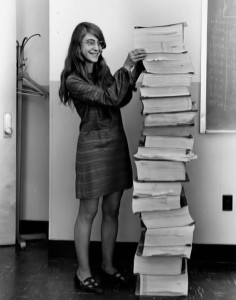The world is not to be put in order. The world is order. It is for us to put ourselves in unison with this order.
Henry Miller
Since 1995, astronomers have pointed our Hubble Space Telescope toward regions of space we previously thought to be “empty” of matter, mapping new views with time exposures lasting days. Now in combination with the Chandra X-ray Laboratory, the November 2014 composite above shows that “empty” space is actually home to uncounted galaxies and worlds beyond our human vision and understanding.
Our space technology and Alexander Gerst delivers amazing views of our planet.
Thank you Alexander for your artistry in creating this incredible experience through your wonderful composition of 12,500 images.

Margaret Hamilton was the lead software engineer for Project Apollo.
It had long been tradition that operating calculating machines was “women’s work”; it was thought to be just keypunching, like typing. Women programmed and operated the punchcard machines to produce calculations for the Manhattan Project. Despite the tendency of the project physicists to minimize their contribution, this was demanding work, much more than just moving cards from slot to slot — they were usually given requirements from the tech people, but often designed the approach and set up the calculations themselves.
The bias that “women do the mere programming” extended into the early days of the computer, and it meant that many of the earliest and most pioneering programmers were women, learning hands-on to do things that had never been done before. We all know about Amazing Grace Hopper, who wrote the first compiler.
Margaret Hamilton earned her BA in math from Earlham College, but obviously learned about programming on the job—there was no other way. In the photo above, she is standing in front of the printouts of the code for the Apollo guidance system, a lot of which she wrote and which she oversaw.
She was all of 31 when the Apollo 11 lunar module landed on the moon, running her code. (Apollo 11 was able to land at all only because she designed the software robustly enough to handle buffer overflows and cycle-stealing.)
She’s now a tech CEO and won the ‘86 Lovelace Award and the NASA Exceptional Space Act Award.
The engineers weren’t all boys with crew-cuts, short sleeve oxford shirts, and narrow black ties.
Original Source: https://medium.com/@3fingeredfox/margaret-hamilton-lead-software-engineer-project-apollo-158754170da8
Live HD Feed from the International Space Station. It may take two clicks to get it going. The feed is from alternating views of 4 different cameras (if screen is black, then the Station is on the dark side of the Earth). If you mouse over “Live” in the right bottom corner of the screen you will see a full screen toggle option.
What makes this so much more compelling to watch than an ordinary satellite feed is that you know there are humans up there with these cameras. The International Space Station travels in orbit around Earth at a speed of roughly 17,150 miles per hour (that’s about 5 miles per second!). This means that the Space Station orbits Earth (and sees a sunrise) once every 92 minutes!
For more information on where exactly the ISS is at this moment, go here: http://eol.jsc.nasa.gov/HDEV/